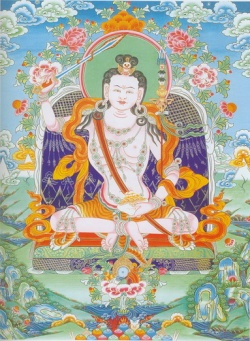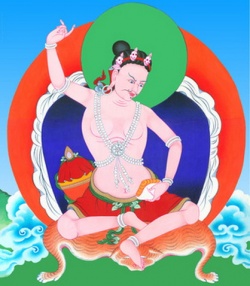Sri Singha
Shri Singha (Sanskrit: Śrī Siṃha, Tibetan: ཤྲི་སིང་ཧ, Wylie: shri sing ha) was a principal Disciple and Dharma-son of Manjushrimitra in the Dzogchen lineage.
Shri Simha was born in China and by the age of eighteen was already a great scholar of the five sciences. In a vision, Avalokiteshvara instructed him to go to the Sosadvipa charnel ground in India where he would attain enlightenment. Pleased to hear such a prophecy, Shri Simha decided he needed to study further in order to prepare for his pilgrimage to India, and so he travelled to the sacred mountain of Wu T'ai Shan, where he studied different Tantras for seven years.
He then took ordination and maintained monastic discipline for thirty years. Avalokiteshvara appeared to him again and repeated his advice. Before departing for India Shri Singa engaged in a practice that resulted in achievement of miraculous powers, allowing him to travel to Sosadvipa very quickly. He met Manjushrimitra there and studied and practised with him for twenty-five years. According to some sources, Shri Simha also studied with Prahevajra directly, later transmitting the teachings to Padmasambhava and Vairotsana.
When Manjushrimitra achieved the rainbow body, Shri Simha received his master's final testament, Gom-nyam Trukpa (The Six Experiences of Meditation), in a casket the size of a fingernail. Realising the essential meaning of Dzogchen, Shri Simha was able to withdraw the texts Manjushrimitra had hidden in the rock near Bodh Gaya. Upon his return to China, he arranged the Me-ngagde teachings of Dzogchen into four cycles: Outer, Inner, Secret and Innermost Secret (Nyingthig, or Heart Essence). He then hid the first three cycles of teaching near the Bodhi Tree Temple in China, and concealed the Nyingthig cycle in a pillar in the Tashi Trigo Temple, entrusting them to the Dharma-protectoress, Ekajati. After this Shri Simha lived in the Siljin charnel grounds in China, meditating and giving teachings. He bestowed the first three cycles of Dzogchen Me-ngagde on Vimalamitra, and all four cycles on Jnanasutra. As Shri Simha achieved the rainbow body his final testament, Zerbu Dunpa (The Seven Nails), descended into the hands of Jnanasutra.
Vajranatha (2007) contextualises Sri Singha in relation to the Nyingma, Manjushrimitra, Tantra, Brahman, Garab Dorje, Uddiyana, Vimalamitra, Samye and Yogachara:
- According to the Nyingmapa tradition of Tibetan Buddhism, the Dzogchen masters Manjushrimitra and Shrisimha were already active in the Tantric milieu in India independently. However, Manjushrimitra, a learned scholar of Brahman origin, was evidently an adherent of the Yogachara school before his becoming a Disciple of the Mysterious Prahevajra or Garab Dorje (dga'-rab rdo-rje) from The country of Uddiyana (Eastern Afghanistan). It should also be recalled that his Disciple Shrisimha was said to have born and resided for sometime in China (more likely Chinese Central Asia, or, more precisely, Burma, as Chogyal Namkhai Norbu told in a talk he had June 15, 2010) before coming to India. And that the latter's Disciple Vimalamitra visited China (or Central Asia) before and after he came to Tibet and transmitted the Dzogchen teachings to his disciples at Samye Monastery.
Nomenclature and etymology
Śrī Siṃha ('Revered Lion') = Pra-pata.
Life
Sri Singha is the son of King 'Accomplisher' and his wife queenNantakā.
A.W. Barber notes that Sri Simha took the Atiyoga lineage to Andhra, in South India. He made his residence at Dhanyakataka.
- "Thus, it would appear that Sri Simha took the Atiyoga line to Andhra and made his residence at the famous Dhanyakataka along the Krishna River. From here it was transmitted to teachers who then took the line to Tibet and China."
Achievements
Śrī Siṃha brought the Secret Mantra teachings from beneath the Vajra Throne in Bodhgaya to the 'Tree of Enlightenment' in China, where he concealed them in a pillar of the 'Auspicious Ten Thousand Gates Temple'.
Śrī Siṃha conferred the Eighteen Dzogchen Tantras (Tibetan: rdzogs chen rgyud bco brgyad)[6] upon Padmasambhava. The eighteen are The Penetrating Sound Tantra (Tibetan: sgra thal ‘gyur), to which was appended the Seventeen Tantras of Innermost Luminosity (Tibetan: yang gsang 'od gsal gyi rgyud bcu bdun).
Kunsang (2006: p.334) in rendering the instructions of Sri Singha to Padmasambhava mentions: 'Phenomena' (Sanskrit: dharmas), 'development' (Tibetan: Kye-rim), completion (Tibetan: Dzog-rim) and Great Perfection, 'three realms' (Sanskrit: Triloka) and the 'six abodes' (Sanskrit: Bhavacakra) and Dharma, Samsara, Nirvana and Sentient beings:
- In general, all Phenomena belonging to Samsara and Nirvana are, from the very beginning, spontaneously perfected as the essence of Awakened Mind. However, because of failing to realize and not knowing this to be just how it is, Sentient beings circle among the three realms and continue to wander among the six abodes. In order to guide them, it is generally said that an inconceivable number of doorways to the Dharma belonging to the various vehicles have been taught, but these can all be contained within development, completion and the Great Perfection.
Kunsang (2006: p.334) in rendering the continued instructions of Sri Singha to Padmasambhava makes reference to nirmanakaya, sambhogakaya and Dharmakaya and outlines:
- ...there are the three sections of the philosophical vehicles belonging to nirmanakaya, the three sections of Kriya and Yoga belonging to sambhogakaya, and the three aspects of development, completion and the Great Perfection belonging to Dharmakaya. Among these, I shall explain to you the Ati Yoga of Instructions, distilling its quintessence, which is the Innermost Vajra Essence of the Unexcelled Fruition. So listen, Padmasambhava.
'Philosophical vehicles' (Tibetan: rgyu'i theg pa) in the abovementioned quotation denotes Theravada and Mahayana as different from Vajrayana. Shri Singha Monastic University
The Shri Singha Monastic University, founded by Gyalse Shenpen Thaye, is a Nyingmapa university in in Eastern Tibet. In the tradition, it is held that a manifestation of Sri Singha marked the spot for the location of the university, hence its name. Do Khyentse Yeshe Dorje consecrated the site laying the 'foundation stone' with his phurba. The original University was destroyed by the Chinese in the "destruction which took place throughout Tibet and China beginning in the late 1950s". The University began to be restored in 1980; the process continues today.

